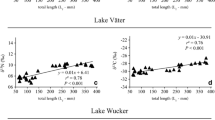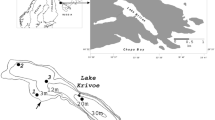Abstract
We present morphology, stable isotope signals and stomach contents of Eurasian perch (Perca fluviatilis) from littoral and pelagic habitats in a brackish water embayment in the northern Baltic Proper. Studies conducted in freshwater habitats repeatedly state that littoral perch have deeper bodies than the pelagic ones. In this study we observed the opposite; the perch from the pelagic study site had deeper bodies than the littoral ones, indicating that more factors than habitat structure affect the perch morphology. A possible explanation to this discrepancy is the diet choice; the pelagic perch in this study were more benthivorous than freshwater pelagic perch. Our results on stable isotope signals combined with the stomach contents also shed new light on the dietary preferences of perch. Perch is known to be a generalist predatory fish, but our results indicate that perch have individual diet preferences. Based on our results, it seems that at some point in their lives the perch in brackish water choose between the littoral and pelagic habitats and also specialise in a certain diet. This study shows that the perch morphology and diet in the Baltic Sea coast differ among habitats, but the patterns are not similar to those observed in freshwater studies.




Similar content being viewed by others
References
Aarnio K, Mattila J, Törnroos A, Bonsdorff E (2011) Zoobenthos as an environmental quality element: the ecological significance of sampling design and functional traits. Mar Ecol 32:58–71
Ådjers K, Appelberg M, Eschbaum R, Lappalainen A, Minde A, Repečka R, Thoresson G (2006) Trends in coastal fish stocks of the Baltic Sea. Boreal Environ Res 11:13–25
Ahlbeck I, Hansson S, Hjerne O (2012) Evaluation of diet analysis methods by individual based modelling. Can J Fish Aquat Sci 69:1184–1201
Allen KR (1935) The food and migration of the perch (Perca fluviatilis) in Windermere. J Anim Ecol 4:264–273
Appelberg M, Berger HM, Hestghagen T, Kleiven E, Kurkilahti M, Raitaniemi J, Rask M (1995) Development and intercalibration of methods in Nordic freshwater fish monitoring. Water Air Soil Pollut 85:401–406
Araujo MS, Guimareas PR Jr, Svanbäck R, Pinheiro A, Guimaraes P, Dos Reis SF, Bolnick DI (2008) Network analysis reveals contrasting effects of intraspecific competition on individual vs. population diets. Ecology 89:1981–1993
Araujo MS, Bolnick DI, Layman GA (2011) The ecological causes of individual specialization. Ecol Lett 14:948–958
Bearhop S, Phillips RA, McGill R, Cherel Y, Dawson DA, Croxall JP (2006) Stable isotopes indicate sex-specific and long-term individual foraging specialization in diving seabirds. Mar Ecol Prog Ser 311:157–164
Beaudoin CP, Tonn WM, Prepas EE, Wassenaar LI (1999) Individual specialization and trophic adaptability of northern pike (Esox lucius): an isotope and dietary analysis. Oecologia 120:386–396
Bergek S, Björklund M (2009) Genetic and morphological divergence reveals local subdivision of perch (Perca fluviatilis L.). Biol J Linn Soc 96:746–758
Bergek S, Sundblad G, Björklund M (2010) Population differentiation in perch Perca fluviatilis: environmental effects on gene flow? J Fish Biol 76:1159–1172
Bolnick DI, Lau OL (2008) Predictable patterns of disruptive selection in three-spined stickleback. Am Nat 172:1–11
Bolnick DI, Svanbäck R, Fordyce JA, Yang LH, Davis JM, Hulsey DC, Forister ML (2003) The ecology of individuals: incidence and implications of individual specialization. Am Nat 161:1–28
Bolnick DI, Amarasekare P, Araujo MS, Bürger R, Levine JM, Novak M, Rudolf VHW, Schreiber SJ, Urban MC, Vasseur DA (2011) Why intraspecific trait variation matters in community ecology? Trends Ecol Evol 26:183–192
Cederberg T (2011) The connection between feeding habits, body depth and environment in Eurasian perch (Perca fluviatilis L.). M.Sc. Thesis, Åbo Akademi Univ
Dall SRX, Bell AM, Bolnick DI, Ratnieks FLW (2012) An evolutionary ecology of individual differences. Ecol Lett 15:1189–1198
Estlander S, Nurminen L, Olin M, Vinni M, Immonen S, Rask M, Ruuhijärvi J, Horppila J, Lehtonen H (2010) Diet shifts and food selection of perch Perca fluviatilis and roach Rutilus rutilus in humid lakes of varying water colour. J Fish Biol 77:241–256
Froese R, Pauly D (eds) (2012) FishBase. www.fishbase.org, version (06/2012). Accessed 1 December 2012
Gerlach G, Schardt U, Eckmann R, Meyer A (2001) Kin-structured subpopulations in Eurasian perch (Perca fluviatilis L.). Heredity 86:213–221
Haahtela I (1990) What do Baltic studies tell us about the isopod Saduria entomon (L.)? Ann Zool Fenn 27:269–278
HELCOM (2012) Indicator based assessment of coastal fish community status in the Baltic Sea 2005–2009. Balt Sea Environ Proc No. 131
Hjelm J, Persson L, Christensen B (2000) Growth, morphological variation and ontogenetic niche shifts in perch (Perca fluviatilis) in relation to resource availability. Oceologia 122:190–199
Horppila J, Ruuhijärvi J, Rask M, Karppinen C, Nyberg K, Olin M (1999) Seasonal changes in the diets and relative abundances of perch and roach in the littoral and pelagic zones of a large lake. J Fish Biol 56:51–72
Hyslop EJ (1980) Stomach contents analysis—a review of methods and their application. J Fish Biol 17:411–429
Jokinen H (2010) The pelagic coastal fish community and its seasonal dynamics, with special consideration for pikeperch: a fishing survey in the Lumparn-area, Åland Islands. MSc Thesis, Åbo Akademi Univ
Kekäläinen J, Kähkönen J, Kiviniemi V, Huuskonen H (2010) Morphological variation of perch Perca fluviatilis in humid lakes: the effect of predator density, competition and prey abundance. J Fish Biol 76:787–799
Kipling C, Le Gren E (1984) Mark–recapture experiments on fish in Windermere. J Fish Biol 24:395–414
Lappalainen A, Rask M, Koponen H, Vesala S (2001) Relative abundance, diet and growth of perch (Perca fluviatilis) and roach (Rutilus rutilus) at Tvärminne, Northern Baltic Sea, in 1975 and 1997: responses to eutrophication? Boreal Environ Res 6:107–118
Lehtovuori H (2008) Abborrens (Perca fluviatilis L.) födokonsumtion, condition och tillväxt I en skärgårdsgradient I nordvästra Åland – kan dessa parametrar relateras till vattnets grumlighet? MSc Thesis, Åbo Akademi Univ
Mattila J (1992) Seasonal and spatial variation in the food choice of perch (Perca fluviatilis L.) in a shallow soft bottom area (SW Finland). In: Bjørnestad E, Hagerman L, Jensen K (eds) Proc. 12th BMB Symposium. Olsen and Olsen, Fredensborg, Denmark. pp 101–107
Mehner T, Schultz H, Bauer D, Herbst R, Voigt H, Benndorf J (1996) Intraguild predation and cannibalism in age-0 perch (Perca fluviatilis) and age-0 zander (Stizostedion lucioperca): interactions with zooplankton succession, prey fish availability and cannibalism. Ann Zool Fenn 33:353–361
Nesbø CL, Magnhagen C, Jakobsen KS (1998) Genetic differentiation among stationary and anadromous perch (Perca fluviatilis) in the Baltic Sea. Hereditas 129:241–249
Nordström M, Aarnio K, Bonsdorff E (2009) Temporal variability of a benthic food web: patterns and processes in a low-diversity system. Mar Ecol Prog Ser 378:13–26
Ólafsson EB (1986) Density dependence in suspension-feeding and deposit-feeding populations of the bivalve Macoma balthica: a field experiment. J Anim Ecol 55:517–526
Olsson J (2006) Interplay between environment and genes on morphological variation in perch—Implications for resource polymorphisms. Dissertation, Uppsala Univ., 55 s
Olsson J, Mo K, Florin A-B, Aho T, Ryman N (2011) Genetic population structure of perch Perca fluviatilis along the Swedish coast of the Baltic Sea. J Fish Biol 79:122–137
Orav-Kotta H, Kotta J (2004) Food and habitat choise of the isopod Idotea baltica in the northeastern Baltic Sea. Hydrobiologia 514:79–85
Perus J, Bonsdorff E (2004) Long-term changes in macrozoobenthos in the Åland archipelago, northern Baltic Sea. J Sea Res 52:45–56
Peterson BJ, Fry B (1987) Stable isotopes in ecosystem studies. Annu Rev Ecol Syst 18:293–320
Post DM (2002) Using stable isotopes to estimate trophic position: models, methods and assumptions. Ecology 83:703–718
Rask M (1986) The diet and feeding activity of perch, Perca fluviatilis L., in a small lake in southern Finland. Ann Zool Fenn 23:49–56
Ricker WE (1975) Computation and interpretation of biological statistics of fish populations. Bull Fish Res Board Can 191:1–382
Sandstöm A, Karås P (2002) Effects of eutrophication on young-of-the-year freshwater fish communities in coastal areas of the Baltic. Environ Biol Fish 63:89–101
Saulamo K, Neuman E (2002) Local management of Baltic fish stocks—significance of migrations. Finfo 2002, No. 9. Available at https://www.havochvatten.se/om-oss/publikationer/fiskeriverkets-publikationer/finfo-fiskeriverket-informerar/finfo/1-31-2012-finfo-20029-local-management-of-baltic-fish-stocks---the-significance-of-migrations.html
Skúlason S, Smith TB (1995) Resource polymorphism in vertebrates. Trends Ecol Evol 10:366–370
Svanbäck R, Bolnick DI (2007) Interspecific competition drives increased resource use diversity within a natural population. Proc R Soc B 274:839–844
Svanbäck R, Eklöv P (2002) Effects of habitat and food resources on morphology and ontogenic growth trajectories in perch. Oecologia 131:61–70
Svanbäck R, Eklöv P (2003) Morphology dependent foraging efficiency in perch: a trade-off for ecological specialization? Oikos 102:273–284
Svanbäck R, Eklöv P (2006) Genetic variation and phenotypic plasticity: causes of morphological and dietary variation in Eurasian perch. Evol Ecol Res 8:37–49
Svanbäck R, Persson L (2004) Individual spezialisation, niche width and population dynamics: implications for trophic polymorphisms. J Anim Ecol 73:973–982
Swedish Board of Fisheries (2006) Fiskebestånd och miljö i hav och sötvatten. Resurs- och miljööversikt. Intellecta Tryckindustri, Solna, Sweden, 151 p. (In Swedish)
Syväranta J, Jones RI (2008) Changes in feeding niche widths of perch and roach following biomanipulation, revealed by stable isotope analysis. Freshw Biol 53:425–434
Vander Zanden MJ, Rasmussen JB (1999) Primary consumer δ13C and δ15N and the trophic position of aquatic consumers. Ecology 80:1395–1404
Acknowledgments
This study was financed by Baltic Sea 2020 Foundation, The Finnish Foundation for Nature Conservation, Åbo Akademi University Endowment and Swedish Cultural Foundation in Finland. Special thanks to Henri Jokinen, Matias Scheinin, Sara Bystedt and Husö biological station. Finnish laws and ethical rules regarding experimental fishing were followed during this study.
Author information
Authors and Affiliations
Corresponding author
Rights and permissions
About this article
Cite this article
Mustamäki, N., Cederberg, T. & Mattila, J. Diet, stable isotopes and morphology of Eurasian perch (Perca fluviatilis) in littoral and pelagic habitats in the northern Baltic Proper. Environ Biol Fish 97, 675–689 (2014). https://doi.org/10.1007/s10641-013-0169-8
Received:
Accepted:
Published:
Issue Date:
DOI: https://doi.org/10.1007/s10641-013-0169-8




